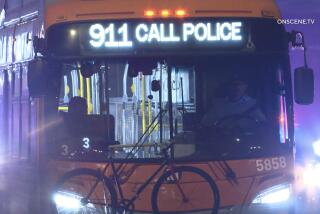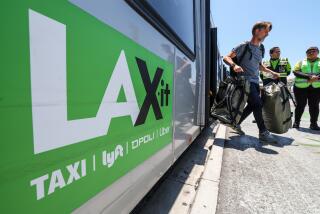Some Riders Make Do, Others Don’t Make It
The MTA strike forged instant friendships among the hapless and a cottage industry for the industrious Tuesday.
Some Angelenos fell to the mercy of friends and strangers, snagging rides in crammed cars and vans. Others, in a day of frustration and improvisation, paid as much as $10 for impromptu shuttles.
“All I know is that I’d get in with anybody right now,” said Jane Dave, 60, who waited an hour at Wilshire Boulevard and Western Avenue for a ride to her dry cleaning shop before paying $3 and edging into a crowded van.
Many would-be transit users simply gave up, opting to stay home rather than navigate a crippled transportation system.
Some were unaware of the strike. At a Panorama City corner, 13-year-old Kaylon Ward shyly asked for a quarter to call his mother to tell her he couldn’t get to Van Nuys Middle School.
Ginger Martinez, 44, of Northridge, gave two quarters to the boy and worried that he might not get home safely.
Others simply hoped against hope for a transit miracle: A bus wending its way along the normal route. Jerry Sanchez, who works in the kitchen of the Skirball Cultural Center, waited patiently at Van Nuys Boulevard and Blythe Street.
“You never know, one bus might slip by,” said the 29-year-old Panorama City resident. “It doesn’t make sense but what are you going to do?”
Some quickly adapted, crafting schemes for ensuring their safe arrival at work. Michelle Yomtov, 60, a legal secretary on her way to Beverly Hills, decided that she would accept a ride in a van driven by a stranger. But she had her own set of rules -- she wouldn’t climb aboard a vehicle with tinted windows.
Not everyone, however, had the cash to fork over to drivers. Carlos Riquelme, 17, tried to cajole a ride to Jefferson High School, just south of downtown. But each driver gave the same answer: “No money, no ride.”
After 30 minutes, Riquelme gave up. The 11th-grader would miss tests in algebra, English and health classes. He shrugged and turned to walk home.
Although most of the city’s bus service was halted, 22 private contractors retained by the MTA continued to operate. Some otherwise stranded passengers boarded those buses, hoping to travel in the general direction that they needed.
Many, however, like William Joyner, found themselves marooned somewhere between home and their destination. Joyner, an usher at Grauman’s Chinese Theatre in Hollywood, usually rides the Red Line subway to work from his home downtown. But after a short ride on a Montebello bus, he was stuck in MacArthur Park.
Joyner kept an anxious eye on the time. “With some luck and footwork ... “ he said, his sentence trailing off.
At bus stops citywide, talk of hassles and hardship inevitably gave way to politics and the merits of the strike. For workers such as Alvaro Juarez, the Metropolitan Transportation Authority’s fleet of 2,400 buses is a lifeline, enabling him to get to a job that he otherwise would be unable to reach.
On Tuesday, Juarez, a 21-year-old immigrant from Mexico, said he might as well start looking for another job if he missed a day.
“They’re going to let me go, no doubt about it,” Juarez said.
So it was impossible for Juarez to sympathize with the striking mechanics, whose pre-strike hourly wage was more than three times the amount he earned. “Here, we’re making $7 an hour and we can’t even get to work,” he said.
The strike hit hardest among the poor and working class. According to a recent MTA study, the median household income for bus riders is $12,000; for train riders, it’s $22,000.
For some workers, including Eleazar Gonzalez, 28, of Van Nuys, the timing of the strike couldn’t have been worse.
After three months of looking for a regular job, on Monday, he got lucky: construction work in Pacific Palisades.
“It’s a good job,” Gonzalez said. “I got my trabajito [little job] yesterday, and I lost it today.”
At several bus stops, people gathered, unclear about their next step. On some corners, people crossed the streets, traveling from one corner to another, in the transit version of a rain dance.
For Vicente Mejia, 22, the trip from the MacArthur Park area to work in Santa Monica was an odyssey. He paid $3 to ride in a van from 3rd and Alvarado streets to Westwood. From there, he jumped into a car that took him for free along Wilshire Boulevard to Barrington Avenue. He walked from there to his job.
Although most MTA passengers ride buses, the work stoppage also stymied those who depend on the agency’s trains.
At 6:40 a.m., a breathless Lucy Galido, 22, of Long Beach, still had not figured out how to get to her computer operator job by 7 a.m. without the Blue Line trolley.
Derek Knowles, a 32-year-old Long Beach resident, stood motionless when he learned why the normally crowded rail platform was empty.
“No buses? No trains?” asked Knowles, who rides the Blue Line to his paralegal job in Los Angeles. “I just sold my car ... I mean -- I’m stuck.”
The sense of immobility jangled many, particularly those who felt they’d been lured into depending upon public transit. For those who used public transportation by choice, Tuesday’s strike raised a critical question: Would they continue to use a system that had proven unreliable?
“This is a no-no,” said Kirk Collins, 43, an investment advisor who takes two buses to get from his Antelope Valley home to his Studio City office. “They get people to take public transportation and then they leave us sitting here waiting.”
*
Times staff writers Jennifer Oldham, Deborah Schoch and Daniel Hernandez contributed to this report.
More to Read
Sign up for Essential California
The most important California stories and recommendations in your inbox every morning.
You may occasionally receive promotional content from the Los Angeles Times.










